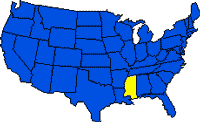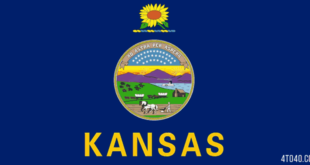 The state of Mississippi borders Arkansas on the northwest, Louisiana on the southwest, Tennessee in the north, and Alabama in the east. In the southeast, Mississippi has a coastline on the Gulf of Mexico that is 71 km (44 mi) long. The state stretches for 530 km (330 mi) from north to south and 290 km (180 mi) from east to west. Mississippi ranks 32d in area among the U.S. states and 31st in population.
The state of Mississippi borders Arkansas on the northwest, Louisiana on the southwest, Tennessee in the north, and Alabama in the east. In the southeast, Mississippi has a coastline on the Gulf of Mexico that is 71 km (44 mi) long. The state stretches for 530 km (330 mi) from north to south and 290 km (180 mi) from east to west. Mississippi ranks 32d in area among the U.S. states and 31st in population.
The first European explorer to arrive in the region was the Spaniard Hernando de Soto, in 1540. The first European settlement was established by the French in 1699 near present-day Ocean Springs. Controlled by the British for the latter part of the 18th century, Mississippi became part of the United States after the Revolutionary War. The state takes its name from the Mississippi River, which forms most of its western boundary.
Land & Resources
 Almost the entire state lies within the eastern Gulf Coastal Plain, which is divided into subregions. The flat Mississippi River Delta stretches along the east bank of the river. The Bluff Hills are located just east of the delta. East of the Bluff Hills three different areas span the state from north to south: the north central hills in the north, the Jackson Prairie in the center, and the Piney Woods in the south. The Black Prairie lies east of the north central hills. In the northeasternmost corner of the state are the Tennessee River Hills, including Woodall Mountain (246 m/806 ft), the highest point in the state. Elevations average 60-155 m (200-510 ft).
Almost the entire state lies within the eastern Gulf Coastal Plain, which is divided into subregions. The flat Mississippi River Delta stretches along the east bank of the river. The Bluff Hills are located just east of the delta. East of the Bluff Hills three different areas span the state from north to south: the north central hills in the north, the Jackson Prairie in the center, and the Piney Woods in the south. The Black Prairie lies east of the north central hills. In the northeasternmost corner of the state are the Tennessee River Hills, including Woodall Mountain (246 m/806 ft), the highest point in the state. Elevations average 60-155 m (200-510 ft).
Rivers and Lakes
The major rivers include the YAZOO and the Big Black, which drain into the MISSISSIPPI RIVER, and the TOMBIGBEE, Pearl, and Pascagoula, which flow into the Gulf. Marshes exist along the coast. The major lakes are artificial. The state has extensive groundwater resources with producing aquifers located throughout the state.
Climate
Mississippi’s climate is subtropical. Mean annual precipitation is 1,346 mm (53 in); local average annual precipitation ranges from 1,676 mm (66 in) along the coast to 1,219 mm (48 in) in the north. Mean annual temperatures vary from 16 deg C (61 deg F) in the north to 20 deg C (68 deg F) along the coast. Summer maximum temperatures average 35 deg C (95 deg F), and winter minimums vary from 0 deg C (32 deg F) in the north to 11 deg C (44 deg F) in the south.
Mississippi is subject to thunderstorms in midsummer and hurricanes in the late summer and early autumn. Snow and sleet are rare.
Historical Sites
Mississippi has seven National Parks Service areas. Rowan Oak, the home where William FAULKNER did most of his writing, is located at Oxford. The Warren County Courthouse in Vicksburg now serves as a Confederate museum. Longwood, an antebellum home, is located at NATCHEZ and is a classic example of a Southern plantation. Grand Village is an excavated Natchez Indian site. Indian mounds are located near Greenville and in the Lake George-Holly Bluff area. Civil War National Battlefields are located at VICKSBURG, Brices Cross Roads, and Tupelo. Life on an 1850 plantation is re-created at Florewood River Plantation, a living history park near Greenwood.
Tourism
Gulf Coast beaches are a major year-round attraction due to Mississippi’s mild winter climate. Those areas experiencing the greatest growth in tourism include the Natchez-Vicksburg area, the Gulf Coast, and the region south of Memphis, Tennessee.
History
Settlement
Prior to European exploration, the northern part of what is now Mississippi was occupied by the CHICKASAWS and the central and southern areas were the home of the CHOCTAWS. Also in the southern region were the NATCHEZ, Biloxi, and Pascagoula. In 1540, Hernando DE SOTO was the first European to visit the region, and he died there in 1542. Robert Cavelier, sieur de LA SALLE, claimed (1682) the Mississippi River valley for France and named it Louisiana. In 1699, Pierre Le Moyne, sieur d’IBERVILLE, established the first permanent French settlement near present-day Ocean Springs. In 1717 the financier John LAW launched the MISSISSIPPI SCHEME to bring settlers and commercial development to the French-held Mississippi River valley. Although the plan collapsed in 1720, it brought large numbers of settlers to the region. Following the French and Indian War (1754-63) the region passed to the British, who included most of the settled area in their colony of West Florida until 1799.
The second Spanish period began in 1781, when Spanish military forces occupied Natchez (in the west), and lasted until 1795, when the region became part of the United States. The territory of Mississippi, with its capital at Natchez, was organized in 1798, and in 1817 Mississippi became the 20th state. By 1832 most of the Indians had been moved to the Indian Territory (present-day Oklahoma), opening new areas to settlement.
From 1832 until secession the state experienced, in succession, a period of prosperity based largely on cotton cultivation and use of slaves, depression, and war with Mexico. It was also a period of growing controversy over slavery. On Jan. 9, 1861, Mississippi seceded from the Union and became the second state to join the Confederate States of America. Jefferson DAVIS, a Mississippi politician, became the president of the Confederacy. For the next four years, about 80,000 Mississippians fought in the Civil War, and several battles were fought in the state, including the VICKSBURG CAMPAIGN (November 1862-December 1863).
Modern Era
The defeat of the Confederate States ushered in the RECONSTRUCTION era, when the state was governed federally. In 1870, Mississippi was readmitted to the Union. In 1890 a new constitution was adopted, which, in part, institutionalized segregation of the races (see JIM CROW LAWS). In the 1890s much in Mississippi seemed little changed from the 1830s. Population distribution was the same, cotton dominated the economy, and blacks–although now free–became economically trapped in the sharecropping system and experienced little change in their status.
During the first term (1916-20) of Governor Theodore BILBO, legislation was enacted that altered the economic, political, and social face of the state by improving state services. Nevertheless, Mississippi entered the 1920s as a rural, agrarian state with rigid segregation and a black majority. A devastating Mississippi River flood in 1927 weakened the economy. The Depression of the 1930s was the most trying economic period for the state. In order to induce industrial growth, and thereby improve the economic climate, the state initiated an ambitious and innovative program called Balancing Agriculture With Industry (BAWI). The discovery of petroleum (1939 and 1940) introduced a major new industry.
World War II brought Mississippi into the modern era by opening it to the outside world and introduced its people to prosperity. Farmers diversified their crops, becoming less reliant on cotton.
With the advent of mechanization, small sharecropping plots were no longer economically viable. Industrialization grew, and by the 1960s employment rolls listed greater numbers of employees in the manufacturing sector than were involved in agriculture.
During the 1960s, Mississippi was a center of the CIVIL RIGHTS movement. Despite the 1954 Supreme Court decision making segregated schools illegal, the state did not quickly institute racial INTEGRATION. In 1962 a black student, James Meredith, attempted to attend the University of Mississippi law school. His admission was blocked, and during the subsequent violence, federal troops were sent to restore order. Violent incidents against blacks took place as the struggle for integration continued. After passage of the Federal Voting Rights Act (1965) many blacks were able to register and vote. In 1969, Charles Evers (see EVERS family) was elected mayor of Fayette and became the first black mayor in the history of the state.
Mississippi’s economic base is now a composite of that of the nation, and social trends are in the direction of national norms rather than southern regionalism. Television, transportation improvements, and the influence of the federal government on the economy and society have greatly affected the state and its people.
Land
- Area: 123,515 sq km (47,689 sq mi); rank: 32d.
- Capital and largest city: Jackson (1990 pop., 196,637).
- Counties: 82.
- Elevations: highest–246 m (806 ft), at Woodall Mountain; lowest–sea level, at the Gulf Coast.
 Kids Portal For Parents India Kids Network
Kids Portal For Parents India Kids Network









